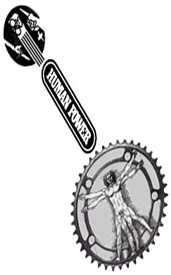Dave’s Ragtime Boogie-Woogie Band
by Richard Ballantine, Chair of the WHPVA
The Human Power archive is a gold mine of technical information. It also traces a record of remarkable human exploration and innovation. Over the 25 years spanned by the Human Power archives, IHPVA members have accomplished incredible feats. The millennia-old dream of true human-powered flight – unassisted take-off, flight, and landing – was realized first with flights over land, then with long distance flights over ocean waters. The performance goal now is acrobatic flight. On land, the 65 mph barrier, once scientifically proven to be the maximum possible speed for a human-powered vehicle, was exceeded long ago. HPV streamliners are now whispering at over 80 mph!
Who are the people doing these things? How do they do them? Who is not easy to say, because the people range from lone, barely in-there eccentrics to well-known, established university professors and technical specialists, from lusty hedonists to refined ascetics. The diversity is enormous. Nevertheless, there are some common characteristics, which may be a clue as to the how.
- Most can think. This ability is very useful if you are trying to figure something out. As the HPV designer John Kingsbury once sagely remarked: “When all else fails – think!”
- Many are well-informed, and respect information and knowledge. Developing new ideas involving, for example, dynamics such as prop cavitation or laminar flow, requires knowledge of these subjects.
- Many are practical, and can design, build, shape, and fix, often with consummate expertise and skill. Direct hands-on involvement with innovative technology is a hallmark of the human power movement.
- Many are well-developed individuals with substance and character, and often, plenty of energy, too! This can make life interesting. When strong-minded people rub each other the wrong way, sparks can shower. Equally, people with distinct personalities and abilities are often better able to appreciate each other, and work effectively together.
- Many have a deep personal involvement with human power, in work, play, sport, or general living, or any combination thereof.
Human power enthusiasts are smart, self-reliant, independent, and sometimes quirky; qualities obviously good for innovation. As well, they care about the quality of their lives. Here, there is an important connection.
From the outset, the human power movement has held a sense of moving in the right direction, of being part of an evolution and change, good for everyone. This feeling has tended to be a tacit understanding, not an active topic. Quite sensibly, human power advocates have focused on achieving practical performances. As a technical journal, Human Power concentrates on qualities such as objectivity, scholarship, empirical validity, and coherent analysis and reasoning. This pragmatic approach has worked very well. Human power in various forms is becoming increasing important in the scheme of things all around the world. Just as we learned practical means for improving the performances of human-powered vehicles and machines, we are developing objective understandings about the effects of human power on society in general, and the quality
of our lives in particular. The commercial vitality of municipalities, the effectiveness of agriculture and the quality of the food we eat, the extent and content of social contacts, the patterns of health and life spans – human power influences all these and more.
The remarkable first 25 years of the human power movement are only a beginning. There is much more and better to come.
Conviction about the bright future of human power has led a small group of enthusiasts to found the Human Power Institute, usually called HuPI, the internet acronym and handle. HuPI’s mission is to promote the development and use of human power through publishing and communications, especially electronic publishing.

The people in HuPI are a microcosm of the human power movement: educated, talented and accomplished, and thoroughly diverse in temperaments! HuPI is widely dispersed, so some members have never met face to face; communications skills are important and are much-used. A deep commitment to human power, in lifestyles and in work, has helped to give cohesion to their union and substance to their efforts.
The Human Power archive began as a private project masterminded and financed by David Gordon Wilson. Others in HuPI quickly volunteered to help, and a chance remark about banjo playing led to nicknaming the team “Dave’s Band”. In producing the Human
Power archive they have labored long and hard to run up a good tune. As matters have developed, it is appearing on the HuPI label.
Will you welcome, please, and give your thanks to:
David Gordon Wilson – Editor of Human Power 1984 to 2002, author of Bicycling Science and other books, professor of Mechanical Engineering emeritus at MIT. A godfather of the human power movement, Dave organized the first modern design contest for human powered vehicles in 1967.
Theo Schmidt – Associate editor of Human Power 1989 to 2002 and editor 2002 to 2004. Vice-president Futurebike Switzerland.
John Snyder – Biologist, technician and resource manager for orbital communications research projects. Artist and writer.
Elrey – Helped design and produce HPV News and Human Power for several years. 80,000 mile HPV commuter and 2004 North American 200m sprint co-champion (tandem).
Brian Wilson – Director of Online Services for HuPI, webmaster for HPVA and IHPVA.
Richard Ballantine – Author of Richard’s 21st Century Bicycle Book and other books, publisher of cycling magazines and environment-related books. Current Chair of the WHPVA, Chair British Human Power Club.
Thanks for your company and enjoy the show!
June 16, 2004


